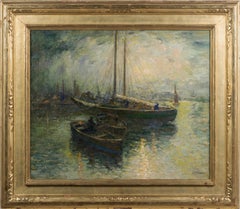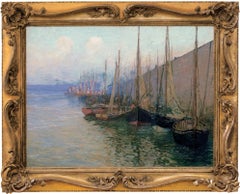Paul King Art
Paul King, an important early 20th century American Impressionist painter, had a prolific and successful career beginning at a young age. In his early teens, he developed a fine competency and appreciation for the arts as a loyal observer in his father’s precious metals workshop, and as an apprentice of the Buffalo lithography firm of Coscak & Company. Having demonstrated a finesse for fine craftsmanship and technique, King was accepted into the Art Students League where the portrait painter, Henry Siddons Mowbray, became his teacher and mentor for four years. During his studies at the New York school, King was employed as an illustrator for Life and Harper’s Magazine, and the American Book Company Publications. King later participated in a Fellowship with the Pennsylvania Academy of the Fine Arts. As soon as King returned from a two year sabbatical in France and Holland with his contemporaries Willy Sluiter, Evert Pieters, and Bernard Bloomers, his talents were recognized by the Salmagundi Club of New York City. He entered a competition there in 1906 with the painting, Hauling in the Anchor Line. This entry won him two of the Club’s top awards. Later, in 1928, he returned to the Salmagundi Club to capture the Isidor Prize with A Cool Retreat. After these first few competitions, Kings’ career began to soar, and he moved from one exhibition to another, collecting prizes, awards, and heightened recognition as an accomplished landscape and genre painter. During the First World War, King served on the United States camouflage unit, creating appropriate patterns for military personnel and machinery. Continuing to actively exhibit, he relocated to Philadelphia where he was invited to join the Board of Directors of the Philadelphia School of Design for Women. He served several years as the board’s Vice President and, in 1915, became its President. Landscapes, seascapes, and rural scenes were all subjects depicted by King, yet most favored by the artist were his coastal and harbor scenes that reflected upon his experiences abroad. King excelled at recreating on canvas the light and atmosphere of a particular time and place. For example, through the use of glazing, a method of painting where a transparent layer of oil paint is laid over a solid one, the artist succeeded in executing works of great subtlety, depth, and texture. Forty-one years after his initiation into lithography and the fine arts, King had his first one-man show at the Ferargil Galleries in New York. Having already received recognition for his modesty, where he was praised by attending contemporaries and critics as one who had captured the majority of cherished art prizes and exhibitions, and consequently earned a place among the top American artists. Further accolades included his fidelity to “real” art and avoidance of the pressing fads. Since he died in 1947, admiration for King’s proficiency in oil painting has only increased. Today, many of his impressionistic paintings are housed in distinguished public and private art collections, and many associations list King as a prestigious member, thus acknowledging him as an important participant in the history of American painting. He was a member of the Allied Artists of America National Academy of Design, Academician American Artists Professional League, National Arts Club, American Federation of Arts, Philadelphia Art Alliance, Artists Aid Society, Philadelphia Art Club, Artists’ Fellowship, Salmagundi Club, New York City Artists Fund Society, Society of Independent Artists, and Bohemian Sketch Club, Buffalo, New York. His works are on display at the Reading Public Museum and Art Gallery, Pennsylvania (Indian Summer); the National Museum of American History, Washington, D.C.; the Cummer Museum of Art and Gardens, Florida; the Farnsworth Art Museum, Maine; the Colby College Museum of Art, Maine; the Rose Art Museum, Massachusetts and the CIGNA Museum and Art Collection, Philadelphia.
1890s Impressionist Paul King Art
Canvas, Oil
Early 1900s American Impressionist Paul King Art
Canvas, Oil
20th Century American Impressionist Paul King Art
Oil, Canvas
20th Century American Impressionist Paul King Art
Canvas, Oil
1930s American Impressionist Paul King Art
Oil, Canvas
1910s American Impressionist Paul King Art
Oil, Canvas
Early 1900s American Impressionist Paul King Art
Canvas, Oil
1910s American Impressionist Paul King Art
Canvas, Oil
20th Century American Impressionist Paul King Art
Oil, Canvas
1910s American Impressionist Paul King Art
Oil, Canvas
20th Century American Impressionist Paul King Art
Oil, Canvas
1910s American Impressionist Paul King Art
Canvas, Oil
1930s American Impressionist Paul King Art
Canvas, Oil


